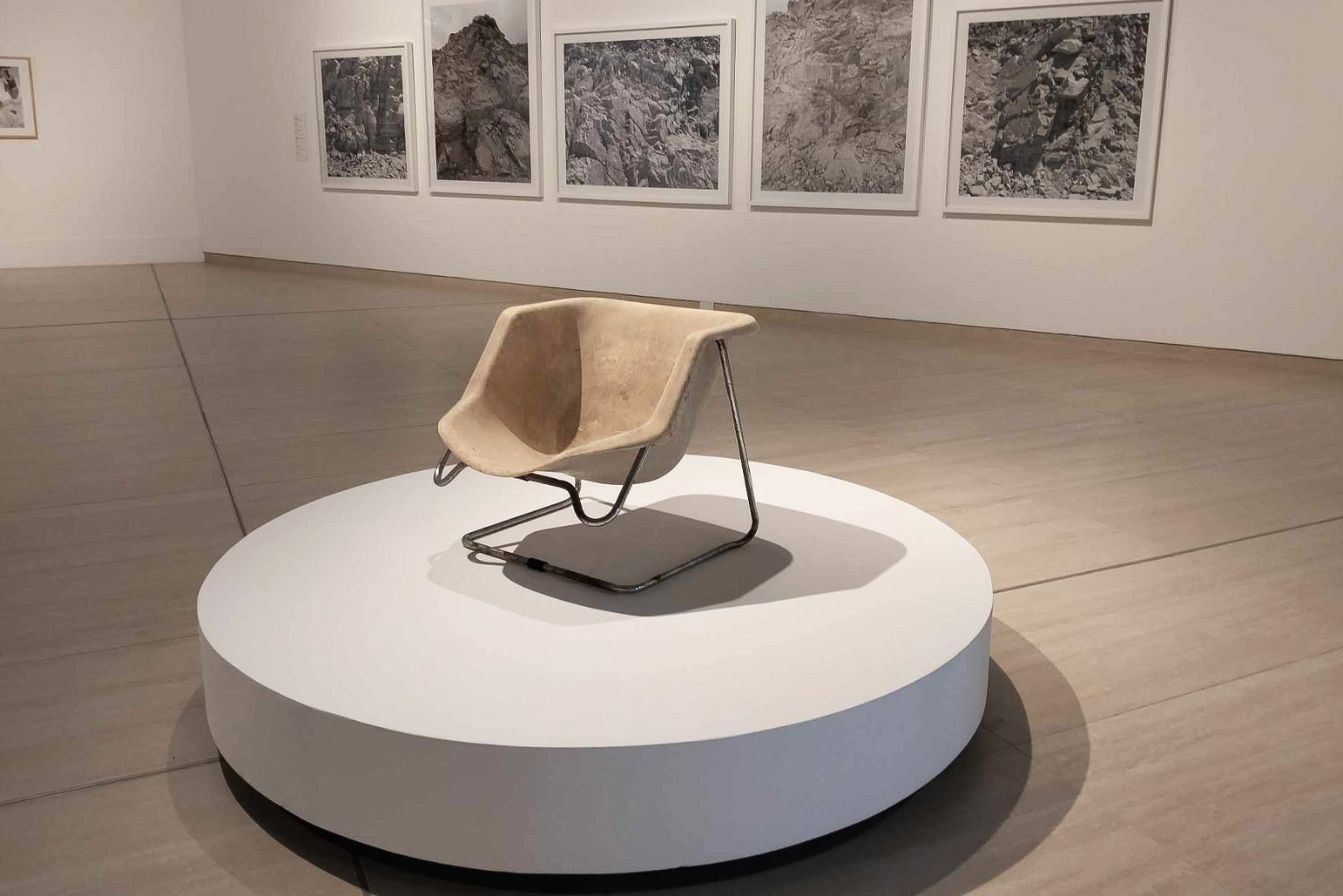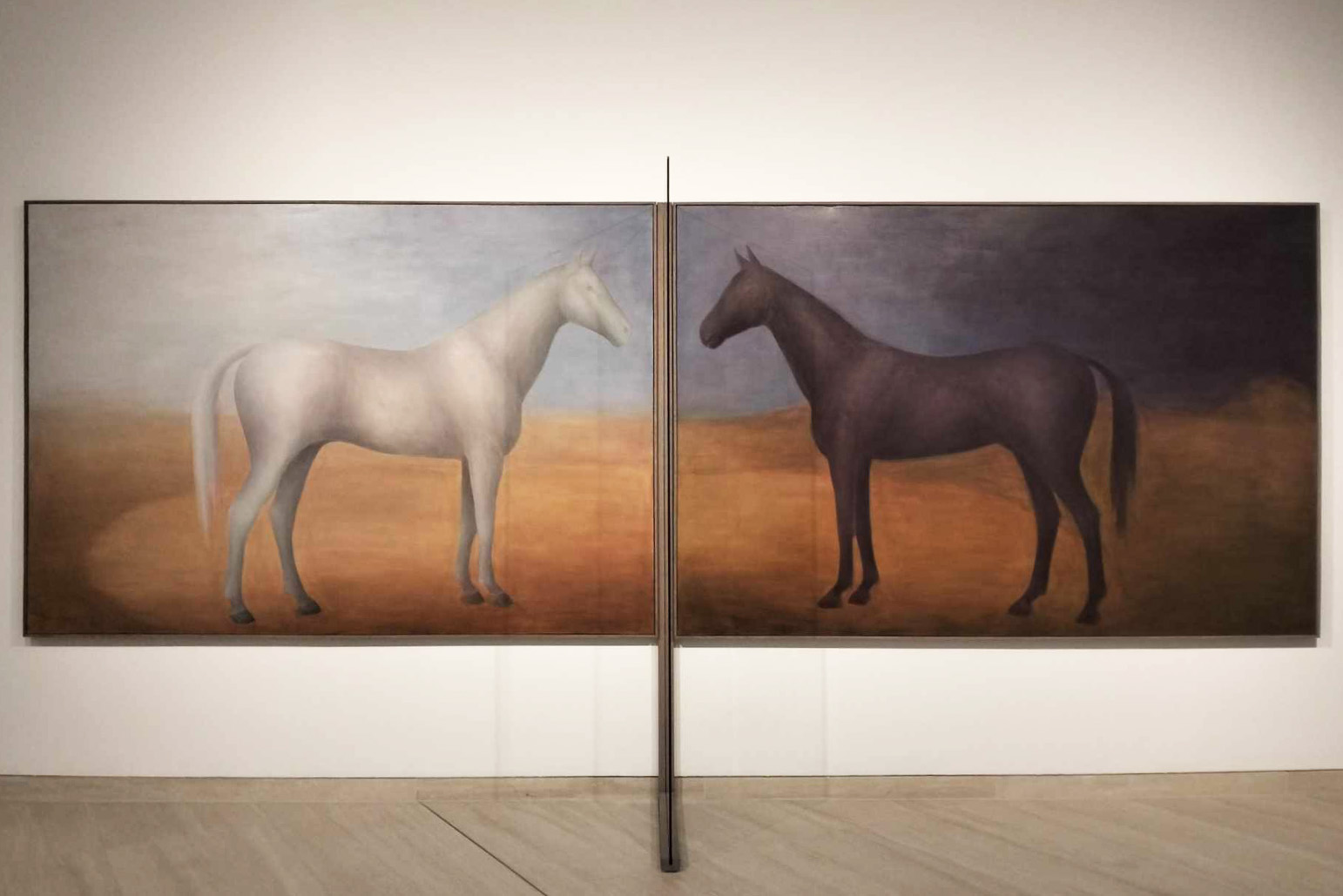

Spacingout, one of AGWA’s more recent exhibitions, promises to showcase works reflecting the ambiguous moments when life leaves us floundering in the unknown. A huge didactic label on the wall begins ‘A subject is shown, shared, and retracted. An idea is floated, lost, and refound’, continuing on, with slight and bold poetic phrases. The curatorial message builds the scene: the stage is set for an exhibition that promises to convey the emotional anguish brought on by the mirage of certainty. Yet, as soon as the opening work comes into view—Alex Israel’s 2018 work Wave, a softly painted, coloured contemporisation of Hokusai’s The Great Wave off Kanagawa—one finds oneself in yet another of AGWA’s more conventional exhibitions. All the promised magic of Spacingout is undone as the curatorial aspirations are once again overshadowed by the gallery’s bleak design.
As coherent as the dozens of works have been put up on the wall in Spacingout, there is nothing significant beyond the works and didactics to carry the curatorial message. At a quick glance (or even a very long one), you would be hard-pressed to find anything unique about the exhibition design in Spacingout. AGWA tends to be unimaginative where it comes to display. Paintings are hung at standard heights, sculptures are placed on inoffensive plinths, and all are illuminated with flat lights on endless glaring white walls. While there is an argument to be made for conventional exhibition elements, the gallery often lets the White Cube and Brutalist architecture of its space dominate at the expense of the exhibitions on display.
In a rare moment for the gallery, the Yoshitomo Nara show earlier this year was a great example of AGWA creating an ambient environment to accentuate the viewing experience. Darker walls, soft spotlighting, and that hypnotising sea of plinths–each masterfully matched to its sculpture. The varying heights, sizes and combinations of big plinths with small sculptures played with the tension in the space, creating movement which brought a mysterious liveliness to Yoshitomo Nara’s body of work.
Whilst Spacingout is far from this, it is not problematic to require that an audience expend effort to view an art exhibition which decisively lacks immersive cues. The better shows tend to invite pensive engagement, and Spacingout certainly has been curated with enough theoretical, formal and conceptual depth to keep any focused onlooker engaged and keenly interested. However, pensive engagement can also arise from experiential engagement facilitated by visually stimulating exhibition designs rather than intentionally crafted arguments on didactics. From the moment you read the first lines of the curatorial statement, it becomes clear that Spacingout (the term itself denoting an experience) would be better suited to a mode of experiential viewing, rather than viewership that required mental gymnastics to communicate its message. With this in mind, it appears Spacingout is a missed opportunity rather than a conceptual misfire.
Nevertheless, there were two moments within the exhibition which grounded the spectator in experientially motivated viewership. The first was Stuart Ringholt’s series of mind-bending chair sculptures. Ringholt investigates the aesthetic forms of chairs, breaking them apart and reassembling them into abstract sculptures. Ringholt surprises his audience by creating sculptures whose familiarity morphs into uncanny and humorous forms as one stalks the floor around them. In line with the exhibition theme, these works point to uncertainty and unravelling expectations, mimicking the state of being ‘spaced out’. But, unlike the other work on display, the audience is able to access the theme not through a theoretical focus, but by being invited into the feeling the exhibition seeks to deliver.
The second impressive work is Sonia Leber and David Chesworth’s two panel video The Way You Move Me. Reimagined in the context of Spacingout, the audio-visual work depicting the WA wheatbelt is projected in a dark room at the centre of the gallery. At first impression, The Way You Move Me feels puzzling and random, like flicking through TV channels and stumbling upon a farming documentary. The offbeat transition to Leber and Chesworth’s video creates a discord which effectively evokes an “out of step” feeling. This emotion carries into the work itself: the disjunction between serene pastoral scenes and disorienting sequences of ambiguous bodies rushing past, masses of muscle pushing and shoving, ushers one into a space of defective focus worthy of the phrase “Spacingout”.
Both of these works draw the viewer into ambiguous spaces through the connections they build within the exhibition. The Way You Move Me directly plays with Rosslynd Piggott’s two panel painting of symmetrical horses—one night, one day—divided by a transparent sheet of glass. The scale and soft brown hues of Piggott form a parallel to The Way You Move Me, but importantly, this connection is felt out as you progress back and forth between the private room and hallway. On the other side of the gallery, another of Ringholt’s chairs is displayed in front of a series of Tony Nathan’s Quarry photographs. The prints, piles of soft grey stone from ambiguous places, lie flat to the wall. And yet, Ringholt’s Untitled (Maquette) chair is covered in scratches of grey dust, as if when no one was looking the chair was caught in Nathan’s quarry stone avalanche. The connection is whimsical, beautiful to behold. The relationship between these two artworks pushes past boundaries to the expansive possibilities which ambiguity entails.
That either Ringholt’s sculptures or Leber and Chesworth’s audiovisual work brings the poetic out-of-jointness from the curatorial statement into the viewing experience appears to be personal or incidental. In comparison to these two happy accidents, the rest of the brilliant curatorial work, research, and artworks in the exhibition fade away. These successes prove how fitting an exhibition design that focused on creating an immersive viewing experience could have been for Spacingout.
Spacingout, 27 May – 17 Sep 2023, The Art Gallery of Western Australia.
Artwork credits:
1. Stuart Ringholt, Untitled (Maquette), 2014, chromed steel and plastic.
2. Rosslynd Piggott, Untitled, 1990-92, oil on linen and sheet glass.
As coherent as the dozens of works have been put up on the wall in Spacingout, there is nothing significant beyond the works and didactics to carry the curatorial message. At a quick glance (or even a very long one), you would be hard-pressed to find anything unique about the exhibition design in Spacingout. AGWA tends to be unimaginative where it comes to display. Paintings are hung at standard heights, sculptures are placed on inoffensive plinths, and all are illuminated with flat lights on endless glaring white walls. While there is an argument to be made for conventional exhibition elements, the gallery often lets the White Cube and Brutalist architecture of its space dominate at the expense of the exhibitions on display.
In a rare moment for the gallery, the Yoshitomo Nara show earlier this year was a great example of AGWA creating an ambient environment to accentuate the viewing experience. Darker walls, soft spotlighting, and that hypnotising sea of plinths–each masterfully matched to its sculpture. The varying heights, sizes and combinations of big plinths with small sculptures played with the tension in the space, creating movement which brought a mysterious liveliness to Yoshitomo Nara’s body of work.
Whilst Spacingout is far from this, it is not problematic to require that an audience expend effort to view an art exhibition which decisively lacks immersive cues. The better shows tend to invite pensive engagement, and Spacingout certainly has been curated with enough theoretical, formal and conceptual depth to keep any focused onlooker engaged and keenly interested. However, pensive engagement can also arise from experiential engagement facilitated by visually stimulating exhibition designs rather than intentionally crafted arguments on didactics. From the moment you read the first lines of the curatorial statement, it becomes clear that Spacingout (the term itself denoting an experience) would be better suited to a mode of experiential viewing, rather than viewership that required mental gymnastics to communicate its message. With this in mind, it appears Spacingout is a missed opportunity rather than a conceptual misfire.
Nevertheless, there were two moments within the exhibition which grounded the spectator in experientially motivated viewership. The first was Stuart Ringholt’s series of mind-bending chair sculptures. Ringholt investigates the aesthetic forms of chairs, breaking them apart and reassembling them into abstract sculptures. Ringholt surprises his audience by creating sculptures whose familiarity morphs into uncanny and humorous forms as one stalks the floor around them. In line with the exhibition theme, these works point to uncertainty and unravelling expectations, mimicking the state of being ‘spaced out’. But, unlike the other work on display, the audience is able to access the theme not through a theoretical focus, but by being invited into the feeling the exhibition seeks to deliver.
The second impressive work is Sonia Leber and David Chesworth’s two panel video The Way You Move Me. Reimagined in the context of Spacingout, the audio-visual work depicting the WA wheatbelt is projected in a dark room at the centre of the gallery. At first impression, The Way You Move Me feels puzzling and random, like flicking through TV channels and stumbling upon a farming documentary. The offbeat transition to Leber and Chesworth’s video creates a discord which effectively evokes an “out of step” feeling. This emotion carries into the work itself: the disjunction between serene pastoral scenes and disorienting sequences of ambiguous bodies rushing past, masses of muscle pushing and shoving, ushers one into a space of defective focus worthy of the phrase “Spacingout”.
Both of these works draw the viewer into ambiguous spaces through the connections they build within the exhibition. The Way You Move Me directly plays with Rosslynd Piggott’s two panel painting of symmetrical horses—one night, one day—divided by a transparent sheet of glass. The scale and soft brown hues of Piggott form a parallel to The Way You Move Me, but importantly, this connection is felt out as you progress back and forth between the private room and hallway. On the other side of the gallery, another of Ringholt’s chairs is displayed in front of a series of Tony Nathan’s Quarry photographs. The prints, piles of soft grey stone from ambiguous places, lie flat to the wall. And yet, Ringholt’s Untitled (Maquette) chair is covered in scratches of grey dust, as if when no one was looking the chair was caught in Nathan’s quarry stone avalanche. The connection is whimsical, beautiful to behold. The relationship between these two artworks pushes past boundaries to the expansive possibilities which ambiguity entails.
That either Ringholt’s sculptures or Leber and Chesworth’s audiovisual work brings the poetic out-of-jointness from the curatorial statement into the viewing experience appears to be personal or incidental. In comparison to these two happy accidents, the rest of the brilliant curatorial work, research, and artworks in the exhibition fade away. These successes prove how fitting an exhibition design that focused on creating an immersive viewing experience could have been for Spacingout.
Spacingout, 27 May – 17 Sep 2023, The Art Gallery of Western Australia.
Artwork credits:
1. Stuart Ringholt, Untitled (Maquette), 2014, chromed steel and plastic.
2. Rosslynd Piggott, Untitled, 1990-92, oil on linen and sheet glass.
